一、实验目的
1.能够编写程序调用OpenDaylight REST API实现特定网络功能;
2.能够编写程序调用Ryu REST API实现特定网络功能。
二、实验环境
1.下载虚拟机软件Oracle VisualBox或VMware;
2.在虚拟机中安装Ubuntu 20.04 Desktop amd64,并完整安装Mininet、OpenDaylight(Carbon版本)、Postman和Ryu;
三、实验要求
(一)基本要求
1.OpenDaylight |
(1) 利用Mininet平台搭建下图所示网络拓扑,并连接OpenDaylight; |

- 在终端使用命令:
sudo mn --topo=single,3 --controller=remote,ip=127.0.0.1,port=6633 --switch ovsk,protocols=OpenFlow10
(2) 编写Python程序,调用OpenDaylight的北向接口下发指令删除s1上的流表数据。 |
- delete.py如下:
#!/usr/bin/python
import requests
from requests.auth import HTTPBasicAuth
def http_delete(url):
url= url
headers = {'Content-Type':'application/json'}
resp = requests.delete(url,headers=headers,auth=HTTPBasicAuth('admin', 'admin'))
return resp
if __name__ == "__main__":
url = 'http://127.0.0.1:8181/restconf/config/opendaylight-inventory:nodes/node/openflow:1/'
resp = http_delete(url)
print (resp.content)
(3) 编写Python程序,调用OpenDaylight的北向接口下发硬超时流表,实现拓扑内主机h1和h3网络中断20s。 |
- sendflow.py如下:
#!/usr/bin/python#!/usr/bin/python
import requests
from requests.auth import HTTPBasicAuth
def http_put(url,jstr):
url= url
headers = {'Content-Type':'application/json'}
resp = requests.put(url,jstr,headers=headers,auth=HTTPBasicAuth('admin', 'admin'))
return resp
if __name__ == "__main__":
url='http://127.0.0.1:8181/restconf/config/opendaylight-inventory:nodes/node/openflow:1/flow-node-inventory:table/0/flow/1'
with open('flow.json') as f:
jstr = f.read()
resp = http_put(url,jstr)
print (resp.content)
- flow.json如下:
{
"flow": [
{
"id": "1",
"match": {
"in-port": "1",
"ethernet-match": {
"ethernet-type": {
"type": "0x0800"
}
},
"ipv4-destination": "10.0.0.3/32"
},
"instructions": {
"instruction": [
{
"order": "0",
"apply-actions": {
"action": [
{
"order": "0",
"drop-action": {}
}
]
}
}
]
},
"flow-name": "flow1",
"priority": "65535",
"hard-timeout": "20",
"cookie": "2",
"table_id": "0"
}
]
}
-
在运行拓扑的终端使用h1 ping h3命令
-
在编写如上sendflow.py和flow.json的文件夹运行sendflow.py,可以观察到如下:
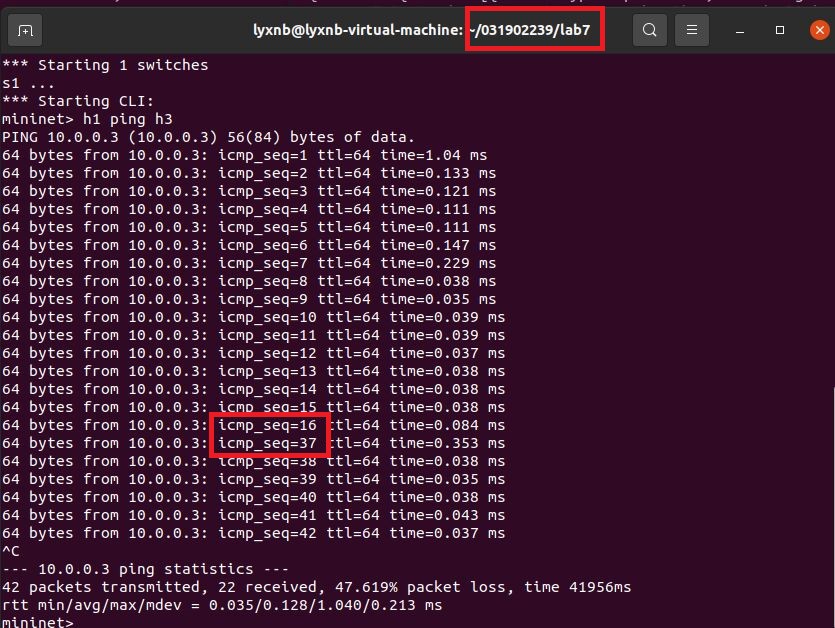
(4) 编写Python程序,调用OpenDaylight的北向接口获取s1上活动的流表数。 |
- get.py如下:
#!/usr/bin/python
import requests
from requests.auth import HTTPBasicAuth
def http_get(url):
url= url
headers = {'Content-Type':'application/json'}
resp = requests.get(url,headers=headers,auth=HTTPBasicAuth('admin','admin'))
return resp
if __name__ == "__main__":
url='http://127.0.0.1:8181/restconf/operational/opendaylight-inventory:nodes/node/openflow:1/flow-node-inventory:table/0/opendaylight-flow-table-statistics:flow-table-statistics'
resp = http_get(url)
print(resp.content)

2.Ryu |
(1) 编写Python程序,调用Ryu的北向接口,实现上述OpenDaylight实验拓扑上相同的硬超时流表下发。 |
- sendflow1.py如下:
#!/usr/bin/python
import requests
if __name__ == "__main__":
url = 'http://127.0.0.1:8080/stats/flowentry/add'
with open("./flow1.json") as f:
jstr = f.read()
headers = {'Content-Type': 'application/json'}
res = requests.post(url, jstr, headers=headers)
print (res.content)
- flow1.json如下:
"dpid": 1,
"cookie": 1,
"cookie_mask": 1,
"table_id": 0,
"hard_timeout": 20,
"priority": 65535,
"flags": 1,
"match":{
"in_port":1
},
"actions":[
]
}
- 结果如下:
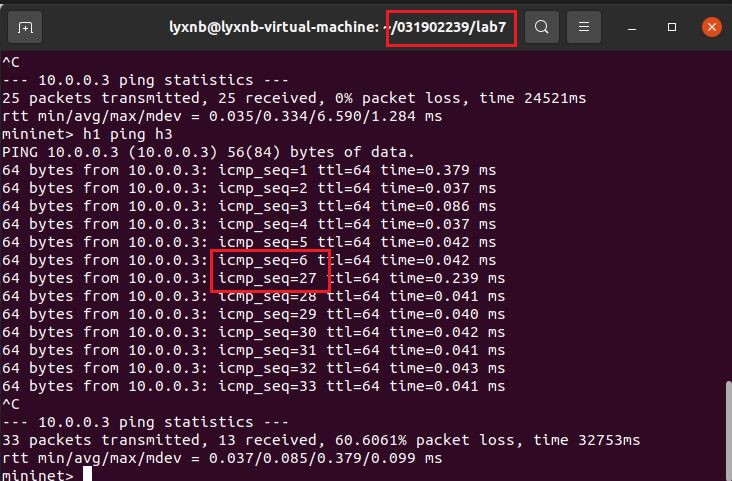
(2) 利用Mininet平台搭建下图所示网络拓扑,要求支持OpenFlow 1.3协议,主机名、交换机名以及端口对应正确。拓扑生成后需连接Ryu,且Ryu应能够提供REST API服务。 |
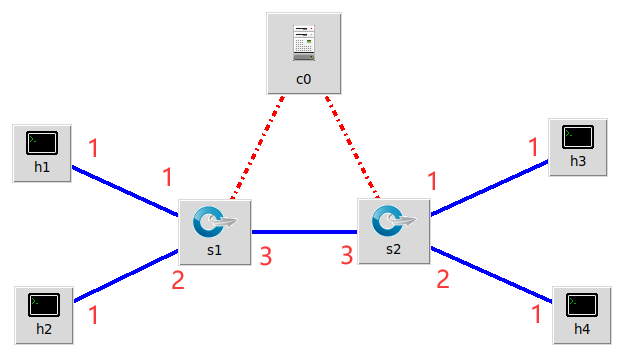
- topo.py文件位置:
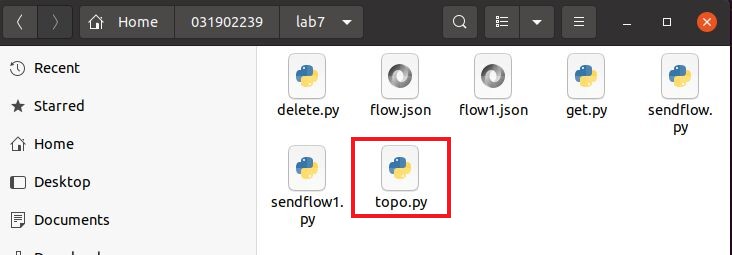
- topo.py:
#!/usr/bin/env python
from mininet.topo import Topo
class MyTopo(Topo):
def __init__(self):
# initilaize topology
Topo.__init__(self)
self.addSwitch("s1")
self.addSwitch("s2")
self.addHost("h1")
self.addHost("h2")
self.addHost("h3")
self.addHost("h4")
self.addLink("s1", "h1")
self.addLink("s1", "h2")
self.addLink("s2", "h3")
self.addLink("s2", "h4")
self.addLink("s1", "s2")
topos = {'mytopo': (lambda: MyTopo())}
- 结果如下:
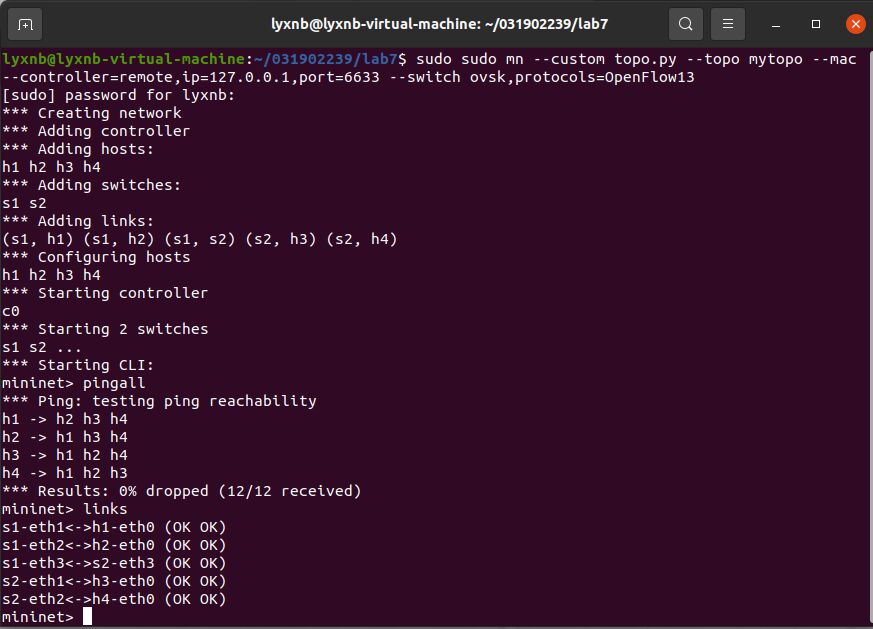
3) 整理一个Shell脚本,参考Ryu REST API的文档,利用curl命令,实现和实验2相同的VLAN。 |
| VLAN_ID | Hosts |
|---|---|
| 0 | h1 h3 |
| 1 | h2 h4 |
- Shell脚本:
# 将主机1,2发送来的包打上vlan标记
curl -X POST -d '{
"dpid": 1,
"priority": 1,
"match":{
"in_port": 1
},
"actions":[
{
"type": "PUSH_VLAN", # Push a new VLAN tag if a input frame is non-VLAN-tagged
"ethertype": 33024 # Ethertype 0x8100(=33024): IEEE 802.1Q VLAN-tagged frame
},
{
"type": "SET_FIELD",
"field": "vlan_vid", # Set VLAN ID
"value": 4096 # Describe sum of vlan_id(e.g. 6) | OFPVID_PRESENT(0x1000=4096)
},
{
"type": "OUTPUT",
"port": 3
}
]
}' http://localhost:8080/stats/flowentry/add
curl -X POST -d '{
"dpid": 1,
"priority": 1,
"match":{
"in_port": 2
},
"actions":[
{
"type": "PUSH_VLAN", # Push a new VLAN tag if a input frame is non-VLAN-tagged
"ethertype": 33024 # Ethertype 0x8100(=33024): IEEE 802.1Q VLAN-tagged frame
},
{
"type": "SET_FIELD",
"field": "vlan_vid", # Set VLAN ID
"value": 4097 # Describe sum of vlan_id(e.g. 6) | OFPVID_PRESENT(0x1000=4096)
},
{
"type": "OUTPUT",
"port": 3
}
]
}' http://localhost:8080/stats/flowentry/add
# 将主机3,4发送来的包取出vlan标记
curl -X POST -d '{
"dpid": 1,
"priority": 1,
"match":{
"vlan_vid": 0
},
"actions":[
{
"type": "POP_VLAN", # Push a new VLAN tag if a input frame is non-VLAN-tagged
"ethertype": 33024 # Ethertype 0x8100(=33024): IEEE 802.1Q VLAN-tagged frame
},
{
"type": "OUTPUT",
"port": 1
}
]
}' http://localhost:8080/stats/flowentry/add
curl -X POST -d '{
"dpid": 1,
"priority": 1,
"match":{
"vlan_vid": 1
},
"actions":[
{
"type": "POP_VLAN", # Push a new VLAN tag if a input frame is non-VLAN-tagged
"ethertype": 33024 # Ethertype 0x8100(=33024): IEEE 802.1Q VLAN-tagged frame
},
{
"type": "OUTPUT",
"port": 2
}
]
}' http://localhost:8080/stats/flowentry/add
# 将主机3,4发送来的包打上vlan标记
curl -X POST -d '{
"dpid": 2,
"priority": 1,
"match":{
"in_port": 1
},
"actions":[
{
"type": "PUSH_VLAN", # Push a new VLAN tag if a input frame is non-VLAN-tagged
"ethertype": 33024 # Ethertype 0x8100(=33024): IEEE 802.1Q VLAN-tagged frame
},
{
"type": "SET_FIELD",
"field": "vlan_vid", # Set VLAN ID
"value": 4096 # Describe sum of vlan_id(e.g. 6) | OFPVID_PRESENT(0x1000=4096)
},
{
"type": "OUTPUT",
"port": 3
}
]
}' http://localhost:8080/stats/flowentry/add
curl -X POST -d '{
"dpid": 2,
"priority": 1,
"match":{
"in_port": 2
},
"actions":[
{
"type": "PUSH_VLAN", # Push a new VLAN tag if a input frame is non-VLAN-tagged
"ethertype": 33024 # Ethertype 0x8100(=33024): IEEE 802.1Q VLAN-tagged frame
},
{
"type": "SET_FIELD",
"field": "vlan_vid", # Set VLAN ID
"value": 4097 # Describe sum of vlan_id(e.g. 6) | OFPVID_PRESENT(0x1000=4096)
},
{
"type": "OUTPUT",
"port": 3
}
]
}' http://localhost:8080/stats/flowentry/add
curl -X POST -d '{
"dpid": 2,
"priority": 1,
"match":{
"vlan_vid": 0
},
"actions":[
{
"type": "POP_VLAN", # Push a new VLAN tag if a input frame is non-VLAN-tagged
"ethertype": 33024 # Ethertype 0x8100(=33024): IEEE 802.1Q VLAN-tagged frame
},
{
"type": "OUTPUT",
"port": 1
}
]
}' http://localhost:8080/stats/flowentry/add
curl -X POST -d '{
"dpid": 2,
"priority": 1,
"match":{
"vlan_vid": 1
},
"actions":[
{
"type": "POP_VLAN", # Push a new VLAN tag if a input frame is non-VLAN-tagged
"ethertype": 33024 # Ethertype 0x8100(=33024): IEEE 802.1Q VLAN-tagged frame
},
{
"type": "OUTPUT",
"port": 2
}
]
}' http://localhost:8080/stats/flowentry/add
- 结果如下:

(二)进阶要求
编程实现基本要求第2部分Ryu(3)中的VLAN划分。 |
- 代码如下:
#!/usr/bin/python
import json
import requests
if __name__ == "__main__":
url = 'http://127.0.0.1:8080/stats/flowentry/add'
headers = {'Content-Type': 'application/json'}
flow1 = {
"dpid": 1,
"priority": 1,
"match":{
"in_port": 2
},
"actions":[
{
"type": "PUSH_VLAN",
"ethertype": 33024
},
{
"type": "SET_FIELD",
"field": "vlan_vid",
"value": 4097
},
{
"type": "OUTPUT",
"port": 3
}
]
}
flow2 = {
"dpid": 1,
"priority": 1,
"match":{
"in_port": 1
},
"actions":[
{
"type": "PUSH_VLAN",
"ethertype": 33024
},
{
"type": "SET_FIELD",
"field": "vlan_vid",
"value": 4096
},
{
"type": "OUTPUT",
"port": 3
}
]
}
flow3 = {
"dpid": 2,
"priority": 1,
"match": {
"in_port": 1
},
"actions": [
{
"type": "PUSH_VLAN",
"ethertype": 33024
},
{
"type": "SET_FIELD",
"field": "vlan_vid",
"value": 4096
},
{
"type": "OUTPUT",
"port": 3
}
]
}
flow4 = {
"dpid": 1,
"priority": 1,
"match":{
"vlan_vid": 0
},
"actions":[
{
"type": "POP_VLAN",
"ethertype": 33024
},
{
"type": "OUTPUT",
"port": 1
}
]
}
flow5 = {
"dpid": 2,
"priority": 1,
"match": {
"in_port": 2
},
"actions": [
{
"type": "PUSH_VLAN",
"ethertype": 33024
},
{
"type": "SET_FIELD",
"field": "vlan_vid",
"value": 4097
},
{
"type": "OUTPUT",
"port": 3
}
]
}
flow6 = {
"dpid": 1,
"priority": 1,
"match": {
"vlan_vid": 1
},
"actions": [
{
"type": "POP_VLAN",
"ethertype": 33024
},
{
"type": "OUTPUT",
"port": 2
}
]
}
flow7 = {
"dpid": 2,
"priority": 1,
"match": {
"vlan_vid": 1
},
"actions": [
{
"type": "POP_VLAN",
"ethertype": 33024
},
{
"type": "OUTPUT",
"port": 2
}
]
}
flow8 = {
"dpid": 2,
"priority": 1,
"match": {
"vlan_vid": 0
},
"actions": [
{
"type": "POP_VLAN",
"ethertype": 33024
},
{
"type": "OUTPUT",
"port": 1
}
]
}
res1 = requests.post(url, json.dumps(flow1), headers=headers)
res2 = requests.post(url, json.dumps(flow2), headers=headers)
res3 = requests.post(url, json.dumps(flow3), headers=headers)
res4 = requests.post(url, json.dumps(flow4), headers=headers)
res5 = requests.post(url, json.dumps(flow5), headers=headers)
res6 = requests.post(url, json.dumps(flow6), headers=headers)
res7 = requests.post(url, json.dumps(flow7), headers=headers)
res8 = requests.post(url, json.dumps(flow8), headers=headers)
- 结果如下:
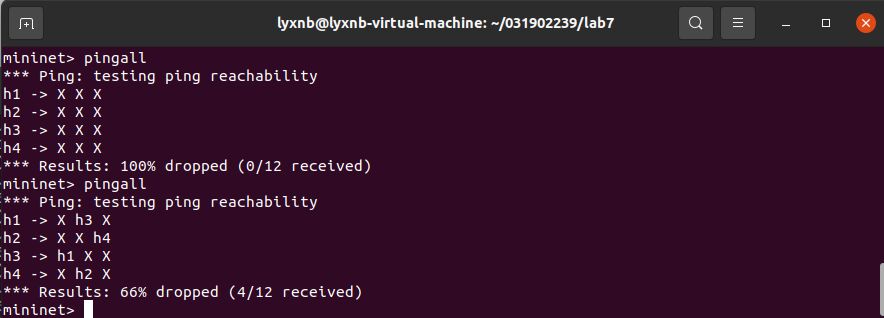
四、个人总结
-
实验难度:较难
-
实验过程遇到的困难及解决办法:
-
刚开始做实验时,使用Python代码调用REST API使用到request的Python包。运行代码产生报错:ImportError: No module named requests,查看老师的pdf指导采用如下命令装pip。
sudo apt-get install python-pip和sudo pip install requests,装后仍然报同样的错,感觉非常不解,卡在这里挺久的也没解决。于是询问老师,在老师的指导下先查看python的版本是否发生变化,查看版本如下:

截图说明默认版本变成2了因此出了问题,在删除旧的软链接并添加新的软链后成功解决了问题。
-
在编写Python程序,调用Ryu的北向接口,实现OpenDaylight实验拓扑上相同的硬超时流表下发时,与同学相同的步骤却在运行py文件后没有得到和同学相同的结果,卡在这个地方很长时间,重启后重新建立拓扑还是没能解决。怀疑代码有点问题,于是重新编写代码解决了问题。
-
个人感想:太难了吧,感觉这次实验都是在写代码,因为刚开始python的版本有问题而卡在开头很长时间挺郁闷的以及在用python调用ryu北向接口做硬超时流表下发时一直没法停止20秒再发,也在这个地方卡了很长时间没办法解决,最后选择了重新写代码,竟然又成功了,但我实在不太明白为什么一样的代码会有不同的结果,还是需要认真、多学吧,这次实验犯过的错以后遇到了也会解决得如鱼得水些。